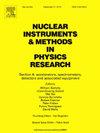Collimated beams of fast neutrons at the NPI CAS
IF 1.5
3区 物理与天体物理
Q3 INSTRUMENTS & INSTRUMENTATION
Nuclear Instruments & Methods in Physics Research Section A-accelerators Spectrometers Detectors and Associated Equipment
Pub Date : 2024-11-12
DOI:10.1016/j.nima.2024.170030
引用次数: 0
Abstract
The Nuclear Physics Institute of the Czech Academy of Sciences operates multiple neutron sources that can produce neutrons with energies up to 33 MeV. Recently, a segmented collimator was constructed to facilitate research on collimated beams of fast neutrons. In front of the collimator, a new quasi-monoenergetic neutron source was built using accelerated protons interacting with a 2.5 mm thick beryllium target. The collimated beam provides a neutron flux of approximately 10 n/cm/s at the standard measurement position.
To determine the parameters of the collimated neutron beam, various measurement techniques were employed, including scintillator-based time-of-flight mode, proton recoil telescope, and activation detection through the (n,2-3n) reaction on a yttrium sample. Furthermore, Monte Carlo simulations were conducted to model the neutron transport through the collimator, and the results were subsequently compared to the experimental data obtained.
NPI CAS 的准直快中子束
捷克科学院核物理研究所拥有多个中子源,可产生能量高达 33 MeV 的中子。最近,该研究所建造了一个分段准直器,以促进对准直快中子束的研究。在准直器前面,利用加速质子与 2.5 毫米厚的铍靶相互作用,建造了一个新的准单能中子源。为了确定准直中子束的参数,采用了多种测量技术,包括基于闪烁体的飞行时间模式、质子反冲望远镜以及通过钇样品上的(n,2-3n)反应进行的活化探测。此外,还进行了蒙特卡洛模拟,以模拟中子通过准直器的传输,并将模拟结果与获得的实验数据进行比较。
本文章由计算机程序翻译,如有差异,请以英文原文为准。
求助全文
约1分钟内获得全文
求助全文
来源期刊
CiteScore
3.20
自引率
21.40%
发文量
787
审稿时长
1 months
期刊介绍:
Section A of Nuclear Instruments and Methods in Physics Research publishes papers on design, manufacturing and performance of scientific instruments with an emphasis on large scale facilities. This includes the development of particle accelerators, ion sources, beam transport systems and target arrangements as well as the use of secondary phenomena such as synchrotron radiation and free electron lasers. It also includes all types of instrumentation for the detection and spectrometry of radiations from high energy processes and nuclear decays, as well as instrumentation for experiments at nuclear reactors. Specialized electronics for nuclear and other types of spectrometry as well as computerization of measurements and control systems in this area also find their place in the A section.
Theoretical as well as experimental papers are accepted.

 求助内容:
求助内容: 应助结果提醒方式:
应助结果提醒方式:


